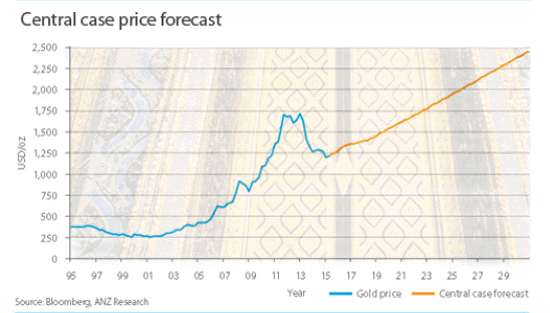
By Warren Hogan and Victor Thianpiriya*
Gold, for centuries the object of fascination and desire, a store of wealth and bedazzling jewellery, has had a wild ride in the last decade and particularly recent years. In the long term though, according to a new report by ANZ Research 'East to El Dorado: Asia and the future of gold', it will continue to glitter.
Emerging Asia is central to the story. The report predicts long term growth in the key consumer markets of China and India, coupled with the development of professional money management across the region, could double annual gold demand in the Asia 10 countries (China, India, Indonesia, Japan, South Korea, Malaysia, Philippines, Singapore, Thailand and Vietnam) from 2,500 tonnes currently to 5,000 tonnes within 15 years.
Asian central banks, long stalwarts of the gold market along with other global reserve institutions, should continue to accumulate physical gold to support the floating of currencies as Asia's financial system develops.
ANZ estimates if all central banks were to allocate 5 per cent of reserves to gold – the global median – this would require an extra 8,000 tonnes of gold, equivalent to almost three years' worth of mine supply.
Asian gold demand will build steadily as its consumption patterns begin to more closely resemble those of the West. A growing middle class will buy more jewellery, a larger body of professional money managers will drive investment demand and regional central banks, whose current holdings lag developed economies, will purchase more gold to provide confidence in newly floated currencies. These factors will, in ANZ's view, support a long term and significant increase in the gold price.
The story of gold has had many plot twists and more are in store.
The emergence of more sophisticated financial systems will provide greater investment opportunities to the people of Asia. This will see a decline in demand for physical gold for precautionary or safe haven reasons – the substitution effect.
The pace of financial market liberalisation and the credibility of financial institutions and policy-makers will determine the impact of this substitution effect on gold prices.
However, given the strong cultural tendency to hold gold in many Asian societies and the uncertain pace of financial liberalisation, ANZ Research expects the net effect of market forces to be positive for gold demand over the next 10-15 years.
Central banks will continue to play a crucial role in the gold market. The period between 1989 and 2009 was characterised by heavy selling by reserve banks, mainly from Europe. Recently, the reverse has been true.

Emerging market central banks have been major buyers of gold and are likely to remain so over the medium to long term. Since the Global Financial Crisis, the central banks of the advanced economies have largely ceased selling their gold holdings.
In the long term, Asian central banks are likely to remain net buyers of gold as their currencies become more freely floating and their strategic focus changes from maintaining currency competitiveness to improving risk-adjusted returns on assets.
Although ANZ currently forecasts a short term weakening of the gold price, it sees the finite supply of gold underpinning a long term increase in its value.
There has been a revival of the gold price from the lows of the 1990s and a resumption of gold's historic role as a defensive asset and store of value during the global financial crisis.
China's increasing role in price setting
Like much of the Asia Century narrative, China will play a bigger role in gold pricing due to its increasing size and importance in the global gold market.
ANZ forecasts the Shanghai Gold Exchange and Shanghai Futures Exchange will continue to build market share in gold trading, amplified by the growing role of the Renminbi in global trade.
With China both the world's largest producer and consumer of physical gold, there is no reason why Shanghai should not become a major centre for gold trading provided the appropriate institutional and legal reforms take place.
Outlook for the gold price – onwards and upwards
The gold price will depend on global economic growth, the level of real interest rates, the actions of central banks and whether China successfully makes the transition to an open economy.
Under ANZ's central case, gold will rise to over $US2,000/oz by 2025 and $US2,400/oz by 2030.
In the nearer term however, prices could remain contained as exchange traded funds continue to exert downward pressure on prices.
Further out, growing wealth in Asia, increasing gold investment by money managers in the region, and expanding gold holdings for central banks in emerging markets will support a continued appreciation of the gold price.
ANZ Research believes an even more bullish case for gold is the next most likely outcome. If China's shift to a more open economy is bumpy and global financial instability continues, there will be strong demand for physical gold, which could see prices rise as high as $US3,230/oz by 2030.
Under a downside scenario for gold, in ANZ's view the least likely to occur, if there is a long run of growth with moderate inflation and rising real interest rates, global asset markets will perform strongly and investment demand for gold will fall.
Given the steady increase in productive capacity for gold over the past decade, the price of gold under this scenario could fall to $US900/oz in 2020 and remain subdued for the forecast period.
In summary, in real (inflation-adjusted) terms, under our bullish case, gold will reach a new record high. Our central case will only see gold prices exceed the 2011 high in real terms after 2030.

Gold is a finite commodity
As global gold demand grows in the coming years, metal supply and demand will be a crucial determinant of price. Supply is constrained as demonstrated by the fact gold production has not increased substantially even during the peak price periods of the last decade.
Gold is unique in that significant stocks of the metal (around 176,000 tonnes) sit above ground. Most of this gold is also captive and the supply of 'scrap' or recycled gold is sensitive to fluctuations in prices.
Higher and more stable prices will be required to ensure enough gold is mined and recycled each year to satisfy rising demand.
--------------------------------
*Warren Hogan and Victor Thianpiriya are chief economist and commodity strategist at ANZ Research. This article first appeared on ANZ's BlueNotes website here.
2 Comments
HAHAHAHA! What is this? Comedy hour?
Gold was a terrible 'store of wealth' during the financial crisis.
You expect gold to reach 2011's high by 2030?!? Thats almost 20 years from now! Yeah, sounds like a great investment.
It depends on your perspective. Gold has been a particularly good investment since 2003 for the buy and hold crowd. And in some countries such as Japan, gold has been a great investment since the GFC. And even during the GFC, gold was a good store of wealth compared to investments in many finance companies in NZ.
We welcome your comments below. If you are not already registered, please register to comment
Remember we welcome robust, respectful and insightful debate. We don't welcome abusive or defamatory comments and will de-register those repeatedly making such comments. Our current comment policy is here.